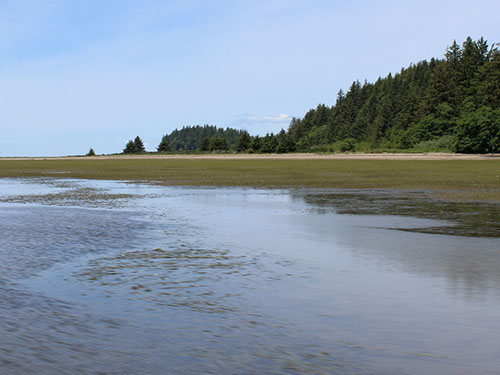Oyster growers have requested a new permit from the Washington Department of Ecology to use the pesticide imidacloprid on burrowing shrimp in Willapa Bay and Grays Harbor. Before considering the permit, Ecology has assessed the potential environmental impacts from the use of the pesticide on tidelands.
Ecology has compiled its findings in a formal report, officially referred to as a Draft Supplemental Environmental Impact Statement, and is seeking public review and feedback through Nov. 1, 2017. Two public meetings have been scheduled in October – one in South Bend and one in Olympia.
The Willapa Grays Harbor Oyster Growers Association (WGHOGA) has specifically applied for a water quality pollution discharge permit and a sediment impact zone authorization. The current proposal is similar – but not identical – to the one submitted by WGHOGA to use imidacloprid in 2015. The applicants propose treating less acreage – 485 acres in Willapa Bay and 15 acres in Grays Harbor – as opposed to 2,000 acres across the two bays in the previous permit. They also propose in this application to treat tidelands with hand or ground equipment as opposed to aerial spraying. The original permit was withdrawn at the growers’ request in May 2015 and never used.
As part of the environmental review process for the current application, Ecology has considered and evaluated new research and analyses that were not available during the previous environmental review. This supplemental review incorporates the most current scientific information available into the full Environmental Impact Statement that was originally adopted in 2015.
Ecology’s supplemental environmental review highlights:
- Immediate adverse, unavoidable impacts to juvenile worms, crustaceans, and shellfish in the areas treated with imidacloprid and the nearby areas covered by incoming tides.
- Limited impacts bay-wide, but significant uncertainty about the cumulative impacts and other unknown impacts, including those to other marine invertebrates and lifecycles.
- Little direct risk to fish, birds, marine mammals, and human health.
- Potential indirect impacts to fish and birds if food sources are disrupted.
- Continued knowledge gaps about imidacloprid. Further research is needed.
The agency will use information gathered during the public comment period to finalize the Supplemental Environmental Impact Statement. This is a crucial step in Ecology’s environmental review required under the State Environmental Policy Act (SEPA). Ecology will rely on this environmental review and public input to help determine whether to develop a draft permit approval for further public comment or deny the permit application.
Learn more and get involved
You can learn more about this issue, review documents, and submit official comments on the agency’s Burrowing Shrimp Control - Imidacloprid webpage.
Learn more about the environmental review of this proposal and submit formal comments in person at an upcoming public hearing:
Saturday, Oct. 7 – South Bend
- Open house: 12 p.m.
- Public hearing: 1 to 3 p.m.
South Bend High School
400 E First Street
South Bend, WA 98586
Tuesday, Oct. 10 – Olympia
- Open house: 6 p.m.
- Public hearing: 7 to 9 p.m.
Lacey Community Center
6729 Pacific Ave. SE
Olympia, WA 98503


